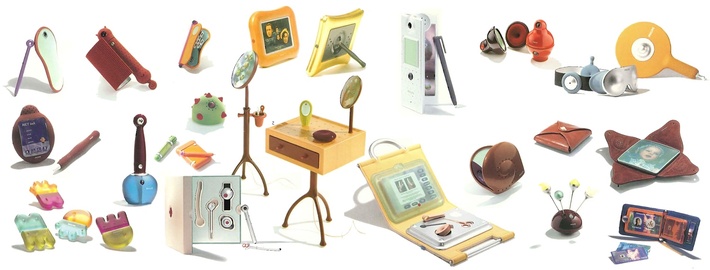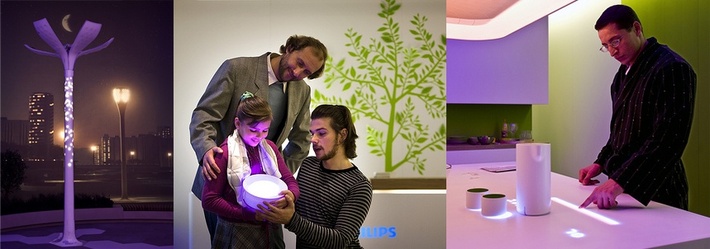Visions by Philips Design
Philips Design is owned by the Dutch multi-national electronics corporation Philips with headquarters in Eindhoven, the Netherlands. It is an independent consultancy, but has a close collaboration with Philips Research and other business divisions. Design has been an essential part of Philips since 1925 and they have presented proposals for radical innovation early in its history, as described in the historic review of future concepts in the preciding chapter.
When the Italian architect Stefano Marzano was appointed head of design in 1992, the consultancy initiated an ambitious endeavour to explore radical innovation. We will start the review with the Vision of the Future project (1996), which marked a milestone in the field of design in its comprehensive analysis and visionary proposals for the year 2005 – far beyond the horizon of conventional market analysis.

Vision of the Future
The objective of the Vision of the Future project was to propose ways in which new technology could improve the quality of people’s lives and show the advantages of changing from a mindset of quantity and complexity towards a focus on quality, simplicity and customer satisfaction. These ideas were to be presented in public in the form of realistic objects and the context in which they could be used, so that people could respond and provide Philips Design with information so they could offer more appropriate products and services in the future.
To start with, extensive research was conducted in two main areas: socio-cultural and technological trends. It was found that the perception of time and space are the main parameters that determine how people will act and think in the coming years. Furthermore, these parameters interact with more specific trends, such as subjectivity, sociability, exploration, connectivity, ethics and holism, to produce a wider variety of behaviour patterns. The technological research identified increasing computing power, voice recognition, virtual agents, smart materials and micro-chip sensors, among others, to be influential for the functionalities of future products.
Next, Philips Design set up multi-disciplinary teams consisting of anthropologists, sociologists, engineers, product designers, etc., who in a series of workshops developed more than 300 scenarios based on socio-cultural and technological research. Thereafter the scenarios were distilled into 60 concept descriptions and categorized according to four main domains of everyday life: personal, domestic, public and mobile.
The study presented a number of smart ways to interact with electronic devices and new functionalities that made it easier for people to gain access to information, communicate with friends and colleagues, monitor and control the home, etc. Apart from the concepts which dealt with the efficiency and ease with which people go about their everyday lives, there was a substantial collection of concepts that addressed more sensible human aspects, such as emotional communicators (and containers) to give assurance, recall a memory, or reinforce a bond. The collection also featured a make-up box for the virtual world to retain privacy and mask identity, and an interactive family tree which could help family members feel closer and more in touch and diminish feelings of separation and isolation.
Unlike the typical future concepts, they were styled in visual language with much reference to the human body and everyday context. With the aim to communicate the concepts to the wider public, the concepts were presented at various exhibitions and events together with video clips illustrating how, where, by whom and for what purpose they might be used. Furthermore, a website and book about the project were produced.
Many of the ideas of the Vision of the Future project were elaborated in more specific studies over the following years. The Home of the near Future project (1999), for example, presented an exploration of the domestic environment and a proposition for the future, while the New Nomads (2001) investigated wearable electronics and smart textiles.
The emerging field of ‘ambient technology’ was given continuous attention by Philips Research and in 2002 they opened a home-like laboratory in which ordinary people could test and experience new concepts. The book The New Everyday (2003) summarized the project. Through the 24 future concepts that Philips had developed in the preceding years they explored the future possibilities of ambient technology. More than 60 experts in technology, design, social sciences and business had participated and presented the 24 concepts which sought to enable a natural and social interaction within the digital environment. Further developments were recorded in the book Ambient Lifestyle (Aarts & Diederiks 2006)
Simplicity
In 2004 the “Let’s make things better” company slogan was substituted by the brand tagline “Sense and simplicity” in order to clearly position Philips as being people-oriented, and not technology-oriented, as in the past. In the following years Philips Design played a key-role in the transformation of the company by outlining the philosophical foundation in the corporate magazine New Value by Design and by presenting future concepts which show how the brand tagline can be translated into concrete products.
From 2005 to 2008 an annual event was hosted to allow customers, media, government representatives and employees to experience radical concepts in a real-like context.
At the first event 25 design concepts demonstrated how the new ‘simplicity-led design’ could shape products over three to five years across the healthcare, lifestyle and technology sectors. The concepts were divided into 5 groups:
- Trust: Making the experience of a MR scan less frightening.
- Care: Control of indoor climate. Growing herbs in the kitchen. Pure drinking water. Soft massage cloth.
- Glow: Intuitive control of the ambience of a room by manipulating colour and intensity of light.
- Play: Capture and projection of still images. Remote control of TV.
- Share: Communication with friends. Watching digital images.
The following year, the main theme was ‘healthy lifestyle’ and 15 “Next Simplicity” concepts were presented with the objective of improving well-being and quality of life for people. The concepts were divided into five sub-themes with direct reference to a person’s physical, mental and social situation:
- Listen to your body: Motivational health rituals to guide you in staying healthy.
- Care for your body: Sensory therapies to energize and rejuvenate your body.
- Move your body: Challenging exercises and games to get you active and keep you fit.
- Relax your mind: Expressive means to engage and soothe your mind.
- Share experiences: Spontaneous ways to share moments and mementos with family and friends.

As the years passed the earlier simplicity-led concepts were further developed, so the Simplicity Event also became a platform for the launch of new products. The 2007 future concepts continued the people-centric approach under the headline “caring for people’s well-being”. Importantly, the objective was now to create an “enabling environment”, rather than individual products. A total of three environments were presented, each containing 2-5 specific future concepts:
- Ambient Healing Space: A hospital room which contributes to the quality of the patient’s health and happiness while providing the caregivers the tools to enable them to enhance the patient’s well-being.
- Celebrating Pregnancy: Pregnancy is not an illness, so ultrasound and other prenatal care should be comfortable and enjoyable for the parents-to-be.
- Daylight: Making a hotel your personal space where you can relax and re-energize after a long journey.
The future concepts for the Simplicity 2008 event were a call for interaction under the headline “Healthy People, Healthy Living, Healthy Planet”. The objective was to empower people to become change agents of their own environment. This is done by increasing people’s daily awareness of and contribution to a better environment. Beyond raising this level of understanding, the concepts explore solutions that deliver both emotional and tangible benefits to those who engage in responsible activities.
- Circle Of Life: Promoting customization and personalization of products as a way of involving customers as creative participants in a product’s life-cycle.
- Light Blossom: An outdoor lighting that transforms the personality of any community from industrial to ecological and uses sustainable sources of energy.
- Green Cuisine: The concept stands for cooking with consciousness by putting relevant knowledge at your finger tips.
Surprisingly, these three future concepts were a departure from the previous years’ increasing focus on healthcare. They introduced a planetary perspective on people’s everyday lives which Philips had not previously explored.

While the Simplicity Event is the uniting theme across all business divisions of Philips, many other research activities take place in parallel. The individual business divisions have their own research centres which collaborate with Philips Design on a regular basis, and Philips Design has programs that design for philanthropy or sustainability, or conduct probes into the far future of 20-30 years. As such, the general exploration of the future is taking more specific forms depending on purpose, value-mission and time-horizon.
Methodology
Philips Design has a wide range of vision projects, which cover the full spectrum from opportunistic future-oriented to value-laden, sustainable innovation projects. These projects deal with complexities of different types, as reflected by their respective methodologies.
Future process
Philips Design divides their exploration of the future into two horizons. The short-term “Culture Scan,” which enables them to keep abreast of developments as they happen, is integrated into the design process and acts as a means to adapt existing technologies to lifestyle trends. For the longer term, Philips Design has developed a “Strategic Futures” process, which looks five to seven years ahead. Anything beyond ten years is thought to be too uncertain, because it is difficult to predict trends for such a long timespan.
The research focuses mainly on technological and social trends, but these depend on a number of factors which are also included in the analysis, such as government policies, international standards, markets and lifestyle.
The Strategic Futures process is divided into five steps (Lambourne et al. 1997; Marzano 2006, p.603):
- Analysis of socio-cultural and technological trends on a regional and global basis.
- Multi-disciplinary teams explore in workshops how the trends interact in specific ways and give rise to new products and services.
- Ideas are selected which are plausible, relevant to the company, and have the greatest potential to make the intended contribution.
- Development of life-like models and simulations. Models are shown to people and feedback is used for developing products that answer the needs of people.
- Revision of the original vision on the basis of the results, leading to a follow-up research project, development of new products or design-related competencies.
Sustainable innovation
Since 2005 Philips’ vision projects are increasingly oriented towards sustainable innovation and less towards the future. The complexity is therefore first and foremost about understanding how products can play a role in people’s lives and how they are influenced by social, technological and economic changes (Bielderman et al. 2007).
- Analysis of people’s daily lives over time, relationships and activities of different stakeholders.
- Envisioning how the final design solution should help to change people’s lives.
- Identifying opportunities for new solutions to fill the gap between the current and the preferred situation.
- Communication of vision to create a common ground within and outside the project team.

Extract from PhD thesis “Everyday-Oriented Innovation”